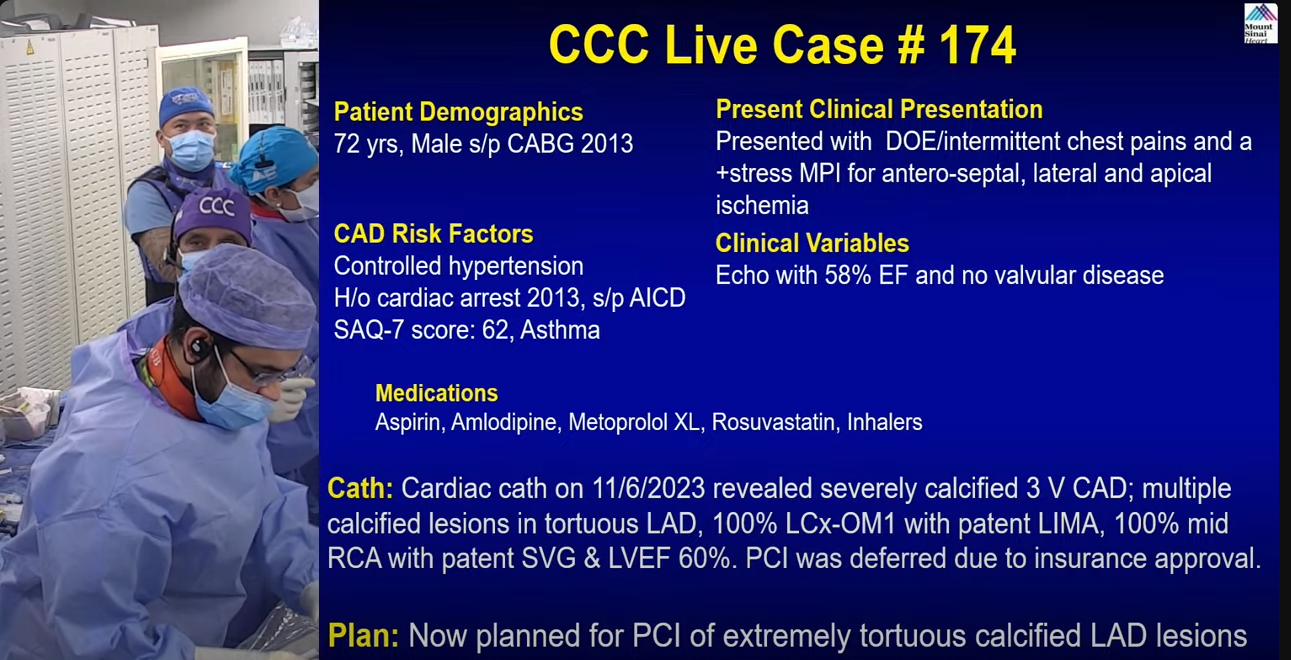Case and Plan:
81-year female with exertional dyspnea and abnormal coronary CTA for 2VD. A Cardiac Cath on January 16, 2024 revealed 2 V CAD: 80% prox LCx, 95% calcified distal LCx, 90-95% multiple calcified nodule in mid RCA with normal systolic LV function and SYNTAX Score of 12. Patient underwent successful intervention of proximal and distal LCx using Rota + 2 Promus Elite DES. Patient is now planned for staged comples PCI or mid RCA calcific nodule using stepped burr RotoTripsy approach.
Q&A
Q
Probably one of the best ccclivecases ever. Congratulations.
A.
We have 2 back to back top ccclive cases demonstrating two specific techniques;
In February- Double MiniCrush technique with 38000+ views in 3-4 weeks.
In March- Large CN of RCA using Stepped Rota burr and IVL (RotaTripsy) with imaging guidance; will find the views this month.
Q
What are the contributors to great success in today's case?
A.
Most important reason of today’s great success is step by step performance of a very complex case with clear cut planning and perfect execution of the plan in case performance, as predicted.
Q
What did you see as the challenges?
A.
Actually there were no true challenges as case was done exactly as the plan was predicted. Of course transient slowflow as predicted occurred and managed well.
Q
You were able to show an appropriate approach to such lesions with excellent demonstration of imaging, rotablator, IVL, and guide extension catheters in a single case - was this planned?
A.
Yes the Stepped burr RotaTripsy was planned with imaging guidance to get the best results and was done.
Q
Based on all technologies for calcified lesions, are rotablator and IVL, the most suitable devices?
A.
Yes both Rota and IVL have excellent device synergy and help to obtain best MSA in severely calcified lesion and in large calcific nodules.
Q
What contributed to today's success - 2.0 burr or IVL?
A.
I have to say that both large burr and IVL worked synergistically in today’s case; 70% Rota and 30% IVL contributions.
Q
What were the biggest challenges you foresaw in this case?
A.
Biggest challenge was occurrence of slow flow during the case after Rota but was transient and resolved quickly with IC vasodilators.
Q
Did the slow flow alarm you at any stage to stop the procedure?
A.
Yes slow flow could very well be problematic if does not resolve quickly by vasodilators. Sometime IABP is inserted in these cases, to prevent it from progressing to no reflow, which could have been very devastating.
Q
At what stage would you have placed an IABP?
A.
Yes IABP was appropriate if slow flow persisted. Hence was not needed in this case.
Q
Is the best lesson from this case the hemodynamic management, ahead of aggressive debulking with Rotablator or IVL?
A.
That is correct that proper hemodynamics especially not letting the SBP go down below 100mmHg is the key in successful performance of Rota cases. Frequent use of IV neosynephrine 100-200mcg boluses every 3-5 minutes to keep SBP short 100 mmHg may be required.





